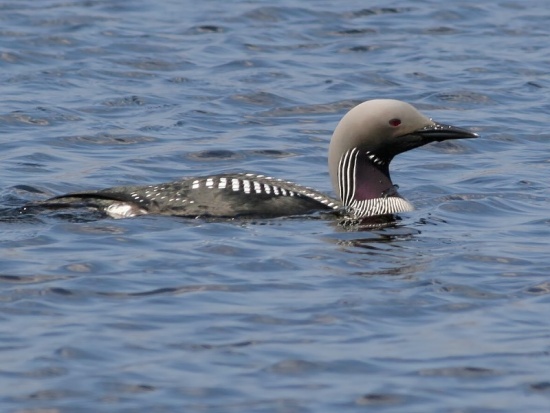Alternative name: Black-throated Diver
- Gavia arctica
Identification
Medium-sized diver between Red-throated and Great Northern in build.
Adult breeding
- Upperparts blackish with rectangular white spots on back,
- Most prominent on scapulars
- White below with black and white streaks on sides of upper breast
- Grey head and neck, palest on hindneck
- Black and white stripes on sides of neck bordering black throat patch
Adult Non-breeding
- Dark grey-brown on head and upperparts
- Clearly demarcated from whtie throat and underparts
- Crown and nape are paler than back (unlike Great Northern)
- Flanks often show a white patch visible on a swimming bird
Similar Species
Intermediate build and bill held straight are best identifying features but very difficult to separate from Pacific Diver and may not be possible with non-breeding birds. Length 68-73cm. Wingspan 120cm.
Distribution
Breeds in northern Scotland and the Hebrides, over much of Scandinavia and the Baltic States and across Russia to Sakhalin and Kamchatka, probably also northern China. Breeds in western Alaska but range unclear due to similarity of this species to the recently split Pacific Diver.
In winter ranges from the Baltic south to Biscay, the northern Adriatic and Black and Caspian Seas and a vagrant on the North African coast and the Canary Islands. In the far east winters off Japan, China and Taiwan. The Siberian race has strayed to the Pacific coast of North America. Accidental vagrant east of Pacific coast but probably often confused as Pacific Loon.
Taxonomy
Subspecies
Three subspecies recognised.
Nominate race breeds across Europe and Russia.
sushkini from western Siberia and Central Asia
viridigularis (green-glossed throat patch) in north-eastern Siberia and western Alaska.
sushkini is not recognised by all authorities[1]
Habitat
Breeds beside medium-large freshwater lakes, often with islands. On passage and in winter moves to coastal areas and occurs on estuaries, bays and sheltered seas.
Behaviour
Breeding
Breeds early-May to September, begins mid-June in north of range. Nests beside water often on an island or spit, a shallow scrape or more rarely a substantial mound of vegetation built in shallow water. Eggs: 2 (1 in replacement clutch), olive-brown, sometimes more greenish with sparse black blotches (84 x 53mm). Incubated by both sexes for 28-29 days. Young tended by both sexes, feed themselves at 35 days and fly at about 60 days
Diet
Fish, also molluscs and crustaceans caught during 45-120 second dives.
Vocalisation
Various wailing, croaking and quacking calls.
References
- Clements, J. F., T. S. Schulenberg, M. J. Iliff, D. Roberson, T. A. Fredericks, B. L. Sullivan, and C. L. Wood. 2014. The eBird/Clements checklist of birds of the world: Version 6.9., with updates to August 2014. Downloaded from http://www.birds.cornell.edu/clementschecklist/download/
Recommended Citation
- BirdForum Opus contributors. (2025) Arctic Loon. In: BirdForum, the forum for wild birds and birding. Retrieved 16 May 2025 from https://www.birdforum.net/opus/Arctic_Loon
External Links
GSearch checked for 2020 platform.1






